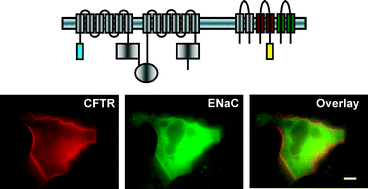Assessment of the CFTR and ENaC association
Abstract
Cystic fibrosis (CF) is one of the most common lethal genetic disorders. It results primarily from mutations in the

* Corresponding authors
a
Departments of Cell Biology and Physiology and Biophysics, University of Alabama at Birmingham, 1918 University Blvd., MCLM 725, Birmingham
E-mail:
berdiev@.uab.edu
Fax: +1 205-934-1445
Tel: +1 205-934-6186
Cystic fibrosis (CF) is one of the most common lethal genetic disorders. It results primarily from mutations in the

 Please wait while we load your content...
Something went wrong. Try again?
Please wait while we load your content...
Something went wrong. Try again?
B. K. Berdiev, Y. J. Qadri and D. J. Benos, Mol. BioSyst., 2009, 5, 123 DOI: 10.1039/B810471A
To request permission to reproduce material from this article, please go to the Copyright Clearance Center request page.
If you are an author contributing to an RSC publication, you do not need to request permission provided correct acknowledgement is given.
If you are the author of this article, you do not need to request permission to reproduce figures and diagrams provided correct acknowledgement is given. If you want to reproduce the whole article in a third-party publication (excluding your thesis/dissertation for which permission is not required) please go to the Copyright Clearance Center request page.
Read more about how to correctly acknowledge RSC content.
 Fetching data from CrossRef.
Fetching data from CrossRef.
This may take some time to load.
Loading related content
